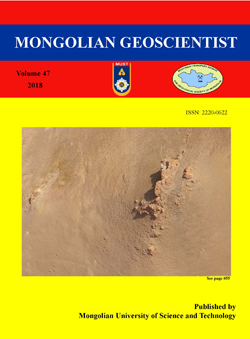New orogenic type gold occurrences in the Uyanga ore knot (Central Mongolia)
DOI:
https://doi.org/10.5564/mgs.v0i47.1062Keywords:
pyrite, arsenopyrite, oxidation, fluid-rock interactionAbstract
The Uyanga ore knot district of the Khangay metallogenic zone are hosted by the lower-middle Devonian volcanogenic-sedimentary Erdenetsogt formation. About 40 samples were collected from the host rocks, veins and quartz veins in the Uyanga ore knot district in 2016. The new Burgetei, Ult and Senjit gold occurrences were studied. The quartz-sulfide, gold-arsenic and gold-antimony-mercury mineralization are determined in the berecitization, silicification, limonitization and glauconization altered metasomatic zones within the Uyanga ore knot districts. The rocks of the Erdenetsogt formation have an irregular gold content: 0.96 g/t Au is determined in quartz vein taken from trench of the Burgetei occurrence (BG-7/16), Au content is highest up to 3.5 g/t in the quartzite-jasper (Ult-7/16 and Ult-9/16) cut by quartz veins in the Ult occurrence. The Senjit occurrence represents Au-Hg-Sb epizonal level of orogenic gold deposits structure with highest Hg content up to 851 ppm. This year no sulfide minerals were found in the siltstone of this occurrence. The Au content of arsenical pyrite of the Burgetei and Ult is below the detection limit by electron microprobe analysis. The Au content of arsenopyrite of the Ult occurrence is highest (up to 238 ppm). Therefore, the ore-mineral assemblages in the gold occurrences reflect the differences between the three explored sites, formed in the course of fluid evolution during the fluid-rock interaction. Variable concentrations of indicative elements (As, Te, Sb, Hg) and their ratios confirm this fact. The geodynamic position, the type of the hydrothermal alteration of both igneous and sedimentary rocks, textures and mineral assemblages, the mineralization sequences are consistent with orogenic classification for the Burgetei, Ult and Senjit gold occurrences.
Downloads
2195
Downloads
Published
How to Cite
Issue
Section
License
Copyright on any research article in the Mongolian Geoscientist is retained by the author(s).
The authors grant the Mongolian Geoscientist a license to publish the article and identify itself as the original publisher.

Articles in the Mongolian Geoscientist are Open Access articles published under a Creative Commons Attribution 4.0 International License CC BY.
This license permits use, distribution and reproduction in any medium, provided the original work is properly cited.








